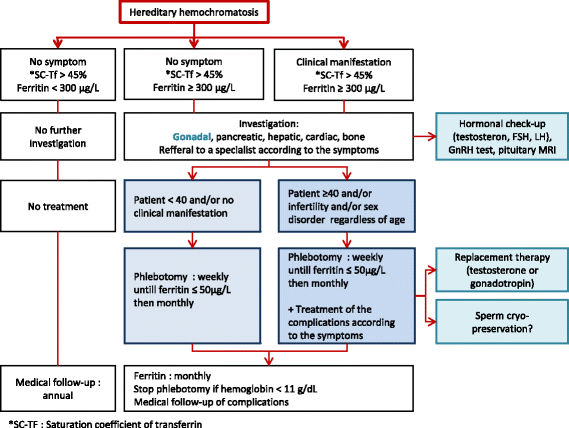Hypogonadotropic hypogonadism in men with hereditary hemochromatosis
- PMID: 28694969
- PMCID: PMC5501943
- DOI: 10.1186/s12610-017-0057-8
Hypogonadotropic hypogonadism in men with hereditary hemochromatosis
Abstract
Hereditary hemochromatosis is a genetic disease that progresses silently. This disease is often diagnosed late when complications appear. Hypogonadotropic hypogonadism (HH) is one of the classical complications of hemochromatosis. Its frequency is declining probably because of earlier diagnosis and better informed physicians. Certain symptoms linked to HH can have an impact on a patient's sexuality, such as decreased libido, erectile dysfunction, and impairment of ejaculation, as well as on his reproductive capacities. This review is based on an online search in English, French and German language publications found in PubMed/Medline, up to 23 September 2016 using the following key word: Male infertility, Hypogonadotropic Hypogonadism, Hereditary Hemochromatosis. Thirty-four papers met these inclusion criteria. This review describes the impact of iron overload on male fertility, resulting in hypogonadotropic hypogonadism and proposes treatment modalities.
L’Hémochromatose Héréditaire est. une maladie génétique qui évolue en silence. Son diagnostic est. souvent fait tardivement, au stade des complications. Même si son incidence diminue, l’Hypogonadisme Hypogonadotrope (HH) est. l’une des complications classiques de l’Hémochromatose. Ceci est. probablement le résultat d’un diagnostic plus précoce, d’une meilleure information des médecins. Certains symptômes en lien avec l’HH, peuvent avoir un impact sur la sexualité (diminution de la libido, dysfonction érectile ou troubles de l’éjaculation…) ainsi que sur la reproduction.Cette revue repose sur une recherche online en langue anglaise, française et allemande de publications disponibles sur PubMed/Medline, jusqu’au 23 sept. 2016 à partir des mots clés suivants: infertilité masculine, hypogonadisme hypogonadotrope, Hémochromatose Héréditaire. Trente quatre publications ont satisfait aux critères de sélection. Cet article de revue décrit l’impact d’une surcharge en fer sur la fertilité masculine, notamment via l’Hypogonadisme Hypogonadotrope qu’elle induit et propose des modalités de traitement.
Keywords: Hereditary Hemochromatosis; Hypogonadotropic Hypogonadism; Male infertility.
Conflict of interest statement
Ethics approval and consent to participate
Not applicable.
Consent for publication
Not applicable.
Competing interests
The authors declare that they have no competing interests.
Publisher’s Note
Springer Nature remains neutral with regard to jurisdictional claims in published maps and institutional affiliations.
Figures



References
LinkOut - more resources
Full Text Sources
Other Literature Sources
Miscellaneous

